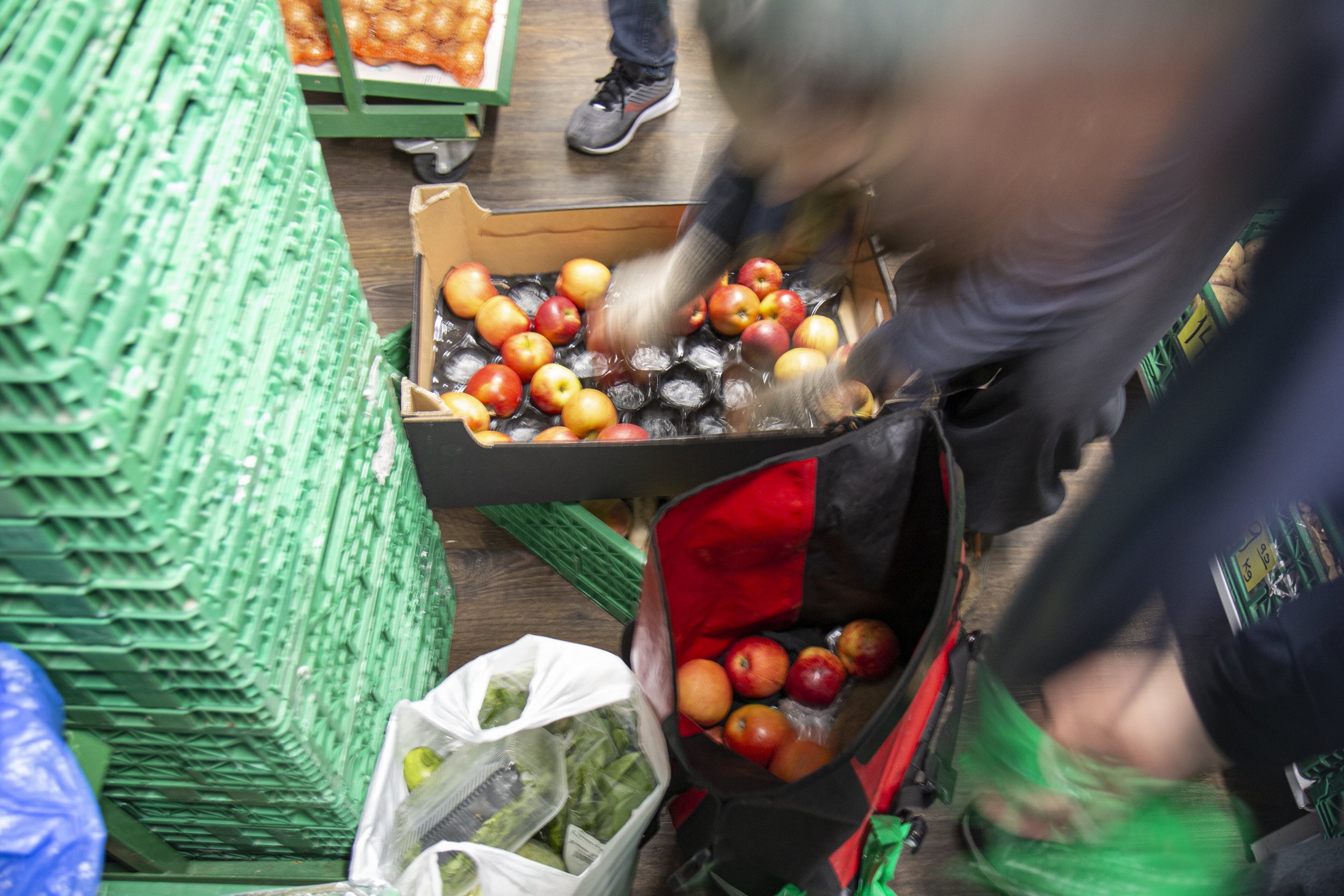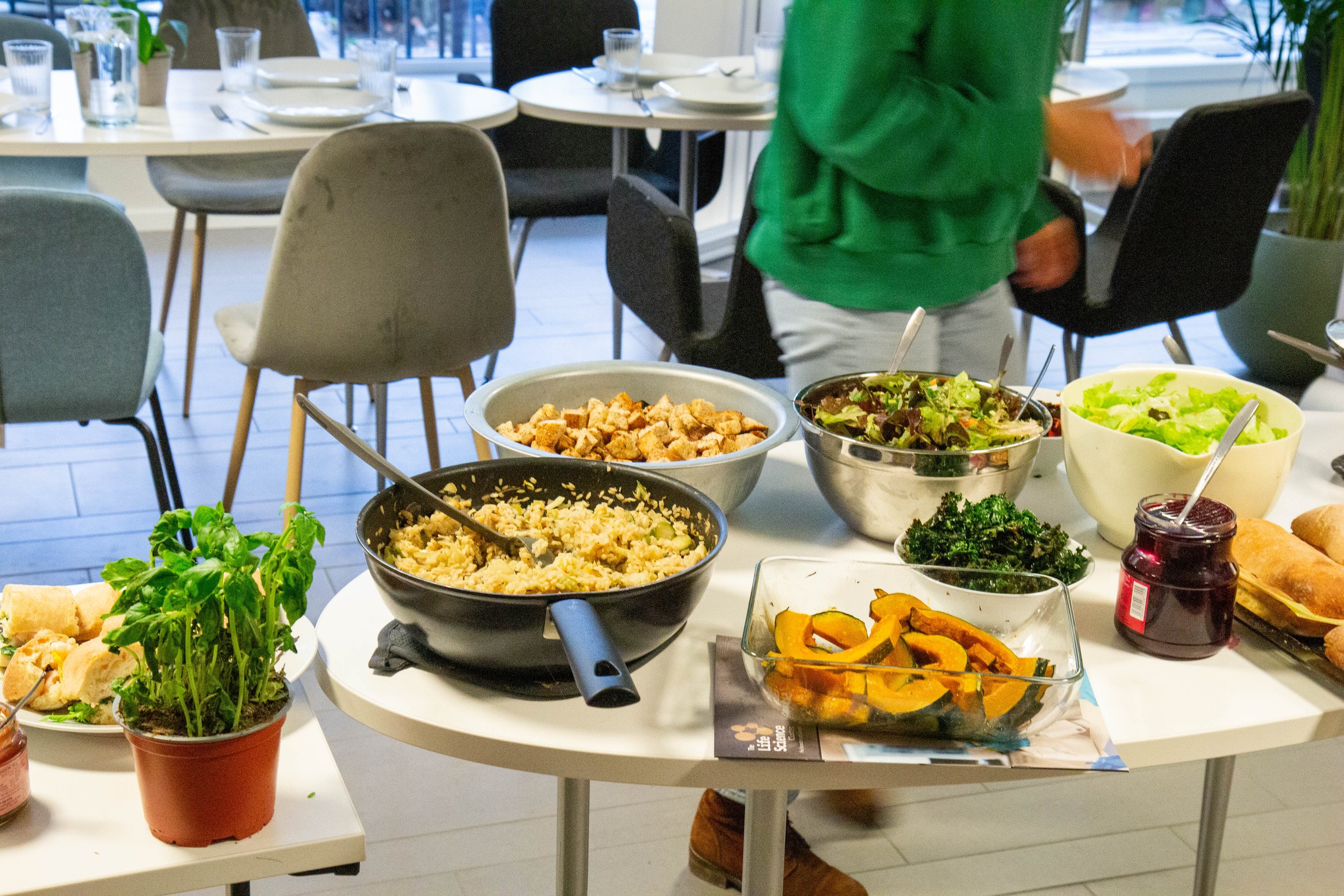FOODSHARING ÅS: FROM WASTING FOOD TO ENJOYING IT

FOODSHARING ÅS; FROM WASTING FOOD TO ENJOYING IT
You, dear reader, are probably one of the almost 3000 members of the Facebook group FOODSHARING ÅS (NMBU). The group that makes Anders Gustavsen turn over in his virtual sleep. Not a member, you say? Allow us to convince you.
Journalist: Åsmund Godal Tunheim
Fotograf: Ingunn Reimers
Web-distributør: Martha Evensen
It’s October, and the cold weather is like a bite to the tip of the nose. I stroll past the windows of the newly opened Innovation Centre in the town centre and come to a sudden halt. Through the glass façade, I see an abundant buffet on the table, piping hot and ready to eat. After a gentle knock, I was let in by a smiling face, and all of a sudden, I am in the middle of Foodsharing’s weekly Friday lunch, where an arsenal of mouthwatering aromas is playing with my nostrils. ‘
More than 20 young people have been tempted to come here this Friday. Coordinator of Foodsharing, Milo Schulthes, welcome us with cheerful words, before the tasty dishes are presented by the cooks. Today’s menu consists of pumpkin soup, oven baked “strange pumpkins” and other vegetables, chiabatta sandwiches, grapes, crunchy croutons, risotto and a wide variety of salads, and dessert in the form of fruit salad and a big, moist cake
“All this food was going to be thrown away, think about that!” photographer Ingunn exclaims. All the food has been heroically saved from the greedy jaws of food waste, either through agreements with shops, dumpster diving or from peoples’ fridges. Best of all? It’s free. The guests attack and conquer, helping themselves diligently. It turns out there are too few chairs and plates, so they have to supplement with more. Moments later, everyone is enjoying the food, and conversations are being held in both English and Norwegian.
A chat about food
I sit down with coordinator Milo and communications manager Nora Marczenko to find out why this exists. “Foodsharing is much more than an organisation, it is a mindset,” says Milo. She says that Foodsharing has existed in Ås for a long time, as an arena to save food that has been thrown away and share it with others. In 2019, they were linked to Spire, and with that, they were established more formally. As a more believable actor, they could enter into agreements with grocery stores about receiving their surplus food products that would otherwise be thrown out, and it became possible to apply for funding via Sparebankstiftelsen. The latter covers Milo’s 20% position as a coordinator, as well as some of Foodsharing’s projects.
The goal of Foodsharing is first and foremost to prevent food waste. Milo emphasises that it should be “more than picking up and giving out food and ’bye bye’”. Even more than the practical aspect, the community is important. “This way, we can change our mindset, meet people and get perspectives on all this food being thrown away, and lastly, experience that this is edible and tasty.” Nora points out. This is not just “food saving” but “food sharing” as the name implies.
About the striking buffet being served today, the duo remarks: Surplus food from only one day and one shop in tiny, little Ås can really feed a lot of mouths. Milo reflects: “Thinking about the amount of food that is not saved, is sickening. If we can do this in little Ås, think about what we can do in Berlin or other big cities.”
More than a free lunch?
What is Foodsharing up to, other than meeting at the Innovation Centre and eating lunch every Friday? Milo tells us that they pick up food from grocery stores, restaurants, cafes, bakeries, and vegetable producers multiple times a week. Other than that, Foodsharing is a big private network of people sharing food they cannot finish themselves. In May, they collaborated with SiÅs in building a drop-off shed at Eplehagen, with a fridge and freezer to help with keeping the food fresh. “When people move, they can put food in the shed. It’s nice to have a place where we can share food that would otherwise be thrown away”, says Nora. Additionally, they put some of the food they save in “Fellesskapet”, a fridge at Innbyggertorget in the town square. Anyone can pick up food here at any time, for free.
“Food is fun, everyone has to eat!” Nora exclaims and emphasises that the most important thing you can do to contribute is to take your share of the food that is saved and distributed. But there are some nuances: “A lot of people want to eat and pick up food in the shed for free. But often, Milo and I are the ones who bring the food, prepare it and serve it here at the Friday lunch. If we disappear…” Milo and Nora hope more people want to get involved in more than just eating, for example by helping with picking up food.
A creative community with room for improvement
At the other tables, the conversations are mainly in English. In Foodsharing, there is a predominance of international people, and Milo says it’s difficult to build a permanent network. On the other hand, she points out the positives: the exchange students come here, participate, go home and maybe they build new networks there.
According to Milo, Foodsharing is a highly creative environment with a constant flow of input, plans and ideas – “and then you just do it.” Among other things, they visit companies and restaurants that work on limiting food waste and go to different events and festivals, all to build a network when it comes to food. On the question of improvement, they say they want to build a bigger, permanent social network in Foodsharing. They want to split it into different responsibilities, so that people can contribute with the things that suit them. In addition to that, they want to collaborate more with SiÅs, by receiving more surplus food from the canteens.
One man’s trash, another man’s treasure
“The concept of trash is strange,” says Milo. “What’s on this table was in the rubbish bins today. Now, it’s here as nice, tasty food.” They do some dumpster diving as well, because even the shops they collaborate with do not give them everything they toss out. Milo explains: “We’re producing way too much, and the consumers have too high standards when it comes to the appearance of the food.” “The consumers don’t want a pumpkin with a small spot”, Nora says. She also points out the problem of multipacks: “You only have time to eat one bell pepper, and then the other one spoils, and you have to throw it away. We live in a world of consumerism.”
When Nora says the food system in Norway is “all at sea”, the journalist has to let out a loud, frustrated sigh. Nora nods, and says: “It’s nice to eat together, but you get frustrated by this, too. That’s why we put so much effort into this.”
The ideal society?
“In an ideal society Foodsharing does not exist, because there is no food waste,” says Milo. She wants to make people familiar with alternatives, show them that you can eat food with imperfections, and that it can be just as tasty. “In the past, people knew how food was produced. We need to take that back,” she says. The attitude adjustment necessary is a huge piece of work, so they need a lot of people.
On the question of how we should tackle food waste, they answer that Foodsharing can be a solution. Meeting each other and speaking about where the food comes from and understanding that food can be delicious even though it looks a bit strange, is an important part of the solution. Consumers have to be less picky, and we have to establish a system based on local, seasonal ingredients, so that food also lasts longer.
When talking about such topics, you easily get the feeling that nothing helps. But Foodsharing is actually doing something about it. “Even though this is demotivating, it’s a highlight to come here every Friday to eat and share food,” Nora says.
Tuntreet is cheering for Foodsharing, who works every day to fix a huge problem. Remember, you could always join the team, and get a lot of scrumptious, free food at the same time. It’s almost too good to be true.
TAKE-AWAY MESSAGES:
Go to the Innovation Center and get served free food every Friday 15-17 o’clock •
Watch the video “Foodsharing Ås” on YouTube
Join the Facebook group. Maybe you will be member number 3000?









